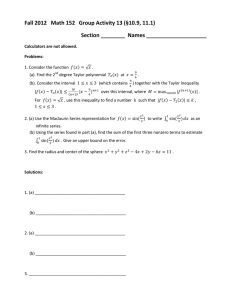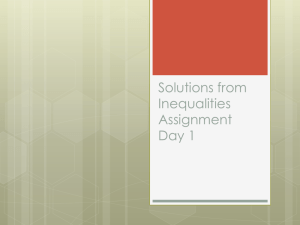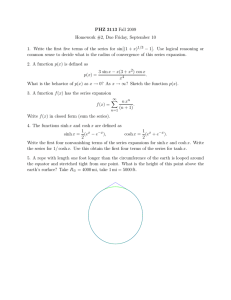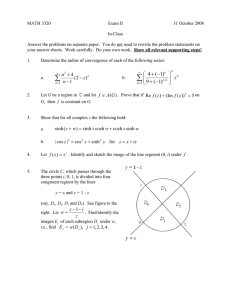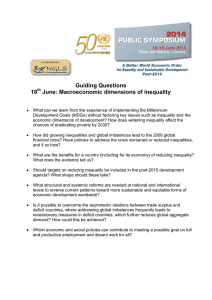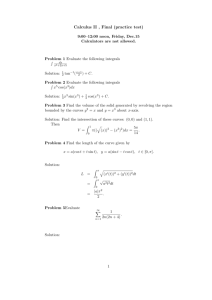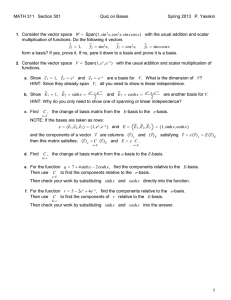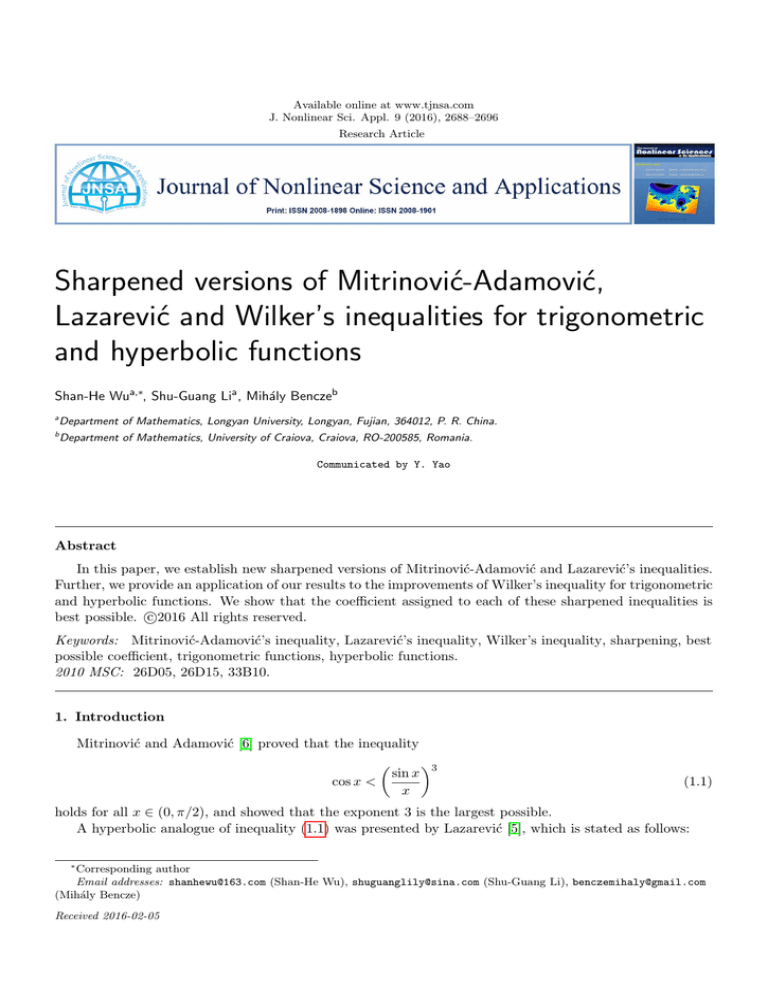
Available online at www.tjnsa.com
J. Nonlinear Sci. Appl. 9 (2016), 2688–2696
Research Article
Sharpened versions of Mitrinović-Adamović,
Lazarević and Wilker’s inequalities for trigonometric
and hyperbolic functions
Shan-He Wua,∗, Shu-Guang Lia , Mihály Benczeb
a
Department of Mathematics, Longyan University, Longyan, Fujian, 364012, P. R. China.
b
Department of Mathematics, University of Craiova, Craiova, RO-200585, Romania.
Communicated by Y. Yao
Abstract
In this paper, we establish new sharpened versions of Mitrinović-Adamović and Lazarević’s inequalities.
Further, we provide an application of our results to the improvements of Wilker’s inequality for trigonometric
and hyperbolic functions. We show that the coefficient assigned to each of these sharpened inequalities is
c
best possible. 2016
All rights reserved.
Keywords: Mitrinović-Adamović’s inequality, Lazarević’s inequality, Wilker’s inequality, sharpening, best
possible coefficient, trigonometric functions, hyperbolic functions.
2010 MSC: 26D05, 26D15, 33B10.
1. Introduction
Mitrinović and Adamović [6] proved that the inequality
cos x <
sin x
x
3
(1.1)
holds for all x ∈ (0, π/2), and showed that the exponent 3 is the largest possible.
A hyperbolic analogue of inequality (1.1) was presented by Lazarević [5], which is stated as follows:
∗
Corresponding author
Email addresses: shanhewu@163.com (Shan-He Wu), shuguanglily@sina.com (Shu-Guang Li), benczemihaly@gmail.com
(Mihály Bencze)
Received 2016-02-05
S. Wu, S. Li, M. Bencze, J. Nonlinear Sci. Appl. 9 (2016), 2688–2696
cosh x <
sinh x
x
2689
3
,
(1.2)
where x 6= 0, and the exponent 3 is the least possible.
A number of generalizations, improvements and applications relating to Mitrinović-Adamović’s inequality
(1.1) and Lazarević’s inequality (1.2) can be found in the literature [4, 7, 9, 12, 15, 19, 20, 21, 22, 26]. Among
these investigations, we remark here that Wu and Baricz [15] dealt with the generalizations of inequalities
(1.1) and (1.2) and obtained two excellent results, as follows:
Theorem 1.1. If 0 < x < π2 , then the inequality
λ λ
1 − + cos x <
3
3
sin x
x
λ
(1.3)
holds if and only if λ < 0 or λ ≥ λ0 , where λ0 ≈ 1.420330769 is the root of the equation λ/3+ (2/π)λ −1 = 0.
Theorem 1.2. If x 6= 0, then the inequality
λ λ
1 − + cosh x <
3
3
sinh x
x
λ
(1.4)
holds if and only if λ < 0 or λ ≥ 7/5.
The main purpose of this paper is to establish new sharpened versions of Mitrinović-Adamović’s inequality (1.1) and Lazarević’s inequality (1.2). Moreover, we provide an application of our results to the
improvements of Wilker’s inequality for trigonometric and hyperbolic functions.
2. Sharpening of Mitrinović-Adamović and Lazarević’s Inequalities
Theorem 2.1. If 0 < x < π2 , then the inequality
cos x <
holds, where the coefficient
12
5
sin x
x
3 12 x 2
1−
1−
5
sin x
(2.1)
is the best possible.
Proof. By the Taylor expansions of sin x and cos x
cos x = 1 −
x2 x4 x6 x8
x2k
(cos θx) 2k+2
+
−
+
− · · · + (−1)k
+ (−1)k+1
x
,
2!
4!
6!
8!
(2k)!
(2k + 2)!
sin x = x −
x3 x5 x7
x2k−1
(cos θx) 2k+1
+
−
+ · · · + (−1)k−1
+ (−1)k
x
,
3!
5!
7!
(2k − 1)!
(2k + 1)!
where 0 < θ < 1, it is easy to observe that
cos x < 1 −
and
1−
x2 x4 x6 x8
+
−
+
2!
4!
6!
8!
x2 x4 x6
sin x
x2 x4
+
−
<
<1−
+
3!
5!
7!
x
3!
5!
(2.2)
(2.3)
S. Wu, S. Li, M. Bencze, J. Nonlinear Sci. Appl. 9 (2016), 2688–2696
2690
for 0 < x < π2 . Using inequalities (2.2) and (2.3) together with a simple calculation, it follows that
cos x −
sin x
x
3 12 7 sin x 3 24 sin x 2 12 sin x
x 2
1−
= cos x +
−
+
1−
5
sin x
5
x
5
x
5
x
2
4
6
8
2
4
3
x
x
x
x
7
x
x
<1−
+
−
+
+
1−
+
2!
4!
6!
8!
5
3!
5!
2
4
6
2
2
24
12
x
x
x
x
x4 −
+
1−
+
−
1−
+
5
3!
5!
7!
5
3!
5!
1
=
x6 263x6 − 13860x4 + 270060x2 − 1820 000
423360000
1
x6 263 × 22 x4 − 13860x4 + 270060 × 22 − 1820000
<
423360000
1
=
x6 (−12808x4 − 739760)
423360000
< 0.
This proves the desired inequality (2.1).
Next, we need to show that the coefficient 12
5 is the best possible in inequality (2.1) in the strong sense.
Consider inequality (2.1) in a general form as
cos x <
sin x
x
3 1−α 1−
x 2
sin x
( sinx x )3 − cos x
⇐⇒ α <
x 2 sin x 3
sin x ) ( x )
(1 −
.
(2.4)
Taking the limit in (2.4) as x → 0, we get
α ≤ lim
x→0
Consequently, the coefficient α =
Theorem 2.1.
12
5
( sinx x )3 − cos x
(1 −
x 2 sin x 3
sin x ) ( x )
=
12
.
5
is the best possible in inequality (2.1). This completes the proof of
Theorem 2.2. For all nonzero real numbers x, the inequality
cosh x <
holds, where the coefficient
12
5
sinh x
x
3
−
12 x 2
1−
5
sinh x
(2.5)
is the best possible.
Proof. We begin by recalling the result asserted by Theorem 1.2 in the introduction section, i.e.,
λ λ
1 − + cosh x <
3
3
Choosing λ =
7
5
sinh x
x
λ
7
, λ ∈ − ∞, 0 ∪
, +∞ .
5
in the above inequality gives
15
cosh x <
7
sinh x
x
7
5
−
8
7
(x 6= 0).
(2.6)
S. Wu, S. Li, M. Bencze, J. Nonlinear Sci. Appl. 9 (2016), 2688–2696
Let
sinh x
x
1
5
2691
= t. Clearly, we have t > 1 in light of the Lazarević’s inequality
1 < cosh x <
sinh x
x
3
(x 6= 0).
Using inequality (2.6) together with a straightforward computation, it follows that
sinh x 3 12 x 2
coshx −
+
1−
x
5
sinh x
7
15 sinh x 5 8
sinh x 3 12 x 2
<
− −
+
1−
7
x
7
x
5
sinh x
8
12
15
2
1 − t−5
= t7 − − t15 +
7
7
5
(t − 1)3 22
=−
t + 3t21 + 6t20 + 10t19 + 15t18 + 21t17 + 28t16
t10
300 14 340 13 372 12 396 11 412 10
+ 36t15 +
t +
t +
t +
t +
t + 60t9
7
7
7
7
7
72 2 36
12
288 7 264 6 228 5
4
3
8
t +
t +
t + 36t + 24t + t + t +
+ 60t +
5
5
5
5
5
5
< 0.
Hence
cosh x <
sinh x
x
3
−
12 x 2
1−
.
5
sinh x
Next, we shall explain why the coefficient 12
5 is the best possible in inequality (2.5).
Consider inequality (2.5) in a general form as
cosh x <
sinh x
x
⇐⇒ β <
we deduce that
3
−β 1−
x 2
sinh x
x 3
( sinh
x ) − cosh x
,
x
2
(1 − ( sinh
x ))
(2.7)
x 3
( sinh
12
x ) − cosh x
= .
x
2
x→0 (1 − (
5
sinh x ))
β ≤ lim
Hence, the coefficient β =
completed.
12
5
is the best possible in inequality (2.5). The proof of Theorem 2.2 is thus
3. Application to the Improvements of Wilker’s Inequality
The inequality
sin x
x
2
+
tan x
>2
x
0<x<
π
2
(3.1)
is called in the literature as Wilker’s inequality (see [8]). This beautiful inequality has evoked the interest
of many authors, and has motivated a lot of research papers involving its proofs, generalizations, variants
and improvements (see [1, 2, 3, 10, 11, 13, 14, 16, 17, 23, 24] and the references therein).
S. Wu, S. Li, M. Bencze, J. Nonlinear Sci. Appl. 9 (2016), 2688–2696
2692
In 2007, an inequality of Wilker-type for hyperbolic functions was presented by Zhu [25]
sinh x
x
2
tanh x
>2
x
+
x 6= 0 .
(3.2)
Recently, Wu et al. [18] gave a sharpening of hyperbolic Wilker-type inequality as follows:
s
x 3 sin x 3 sinh x 2 tanh x
+
>2 1+
cos x −
x 6= 0 .
x
x
sinh x
x
(3.3)
In this section, we establish new sharpened versions of Wilker’s inequality for trigonometric and hyperbolic functions.
Theorem 3.1. If 0 < x < π2 , then we have the inequality
where the coefficient
32
5
sin x
x
2
+
32 tan x
x 2
>2+
1−
,
x
5
sin x
(3.4)
is the best possible.
Proof. In order to prove inequality (3.4), it suffices to prove that the following inequality
sin x 2
x
+
1−
sin x
x cos x
2
x
sin x
−2
32
5
>
holds for 0 < x < π2 .
By using the result of Theorem 2.1
cos x <
sin x
x
3 12 x 2
1−
1−
,
5
sin x
x ∈ 0,
1−
π
,
2
we obtain
sin x 2
x
1
Let
sin x
x
x
+ xsin
cos x
2
− sinx x
−2
= t. We conclude
2
π
sin x 2
x
>
+
sin x
x
sin x 3
x
1−
12
5
2
x
sin x
1−
2
x
sin x
< t < 1 by virtue of the Jordan’s inequality (see [7])
2
sin x
<
< 1,
π
x
x ∈ 0,
π
.
2
A direct calculation gives
sin x 2
x
sin x
x
+
sin x 3
x
1−
t2 + t t3 1 −
=
=
−1
12
5
1−
7t4
12
5
2
x
sin x
1−
1−
1 2
1 2
t
1−
2
x
sin x
−1
−1
−2
t
10t3
−
− 29t2
.
7t2 − 24t + 12
Consider the function
f (t) =
7t4 − 10t3 − 29t2
,
7t2 − 24t + 12
t∈
2 ,1 .
π
−2
−2
.
(3.5)
S. Wu, S. Li, M. Bencze, J. Nonlinear Sci. Appl. 9 (2016), 2688–2696
2693
Differentiating f (t) with respect to t gives
0
f (t) =
2t 168t + 408t2 − 287t3 + 49t4 − 348
(7t2 − 24t + 12)2
−2t (7t (27 − 7t) + 19) (t − 1)2 + 319(1 − t) + 10
=
(7t2 − 24t + 12)2
< 0,
where π2 < t < 1.
It follows that f (t) is decreasing on ( π2 , 1). Consequently,
32
for t ∈
5
f (t) > f (1) =
2 ,1 ,
π
that is,
sin x 2
x
+
sin x
x
sin x 3
x
12
5
2
x
sin x
1−
1−
1−
2
x
sin x
−1
−2
>
32
.
5
By inequality (3.5), we get
sin x 2
x
+
1−
sin x
x cos x
2
x
sin x
−2
which implies the desired inequality (3.4).
Next, we shall prove the assertion that the coefficient
Consider inequality (3.4) in a general form as
2
sin x
x
+
32
5
>
32
,
5
is the best possible in inequality (3.4).
tan x
x 2
>2+γ 1−
x
sin x
⇐⇒ γ <
( sinx x )2 + tanx x − 2
.
(1 − sinx x )2
(3.6)
Taking the limit in (3.6) as x → 0, we obtain
( sinx x )2 + tanx x − 2
32
= .
x
2
x→0
(1 − sin x )
5
γ ≤ lim
Consequently, the coefficients γ =
of Theorem 3.1.
32
5
is the best possible in inequality (3.4). This completes the proof
Theorem 3.2. For all nonzero real numbers x, the following inequality holds
where the coefficient
8
5
sinh x
x
2
tanh x
8
+
>2+
x
5
1−
x 2
sinh x
2
,
is the best possible.
Proof. To prove inequality (3.7), it is enough to prove that the following inequality
x 2
( sinh
x ) +
(1 −
tanh x
−
x
2
x
)2
sinh2 x
2
>
8
5
(3.7)
S. Wu, S. Li, M. Bencze, J. Nonlinear Sci. Appl. 9 (2016), 2688–2696
2694
holds for x 6= 0.
By appealing to inequality (2.6) mentioned in Section 2, i.e.,
15
cosh x <
7
sinh x
x
7
−
8
7
sinh x
x
5
(x 6= 0),
we obtain
sinh x 2
x
Let
sinh x
x
15
1−
tanh x
−
x
2
2
x
sinh2 x
+
2
sinh x 2
x
8
− >
5
+
1−
15
7
sinh x
x
x2
2
57
−
8
7
−1
−2
2
8
− .
5
sinh x
= t. Obviously, one has t > 1 in light of Lazarević’s inequality
sinh x 3
1 < cosh x <
(x 6= 0).
x
Then, we have
sinh x 2
x
+
sinh x
x
=
=
t10 +
15
7
sinh x
x
−
8
7
−1
−2
−
2
x2
sinh2 x
8 −1
7
t5 15
7 t − 7
(1 − t−10 )2
1−
57
−2
−
8
5
8
5
75t37 − 40t30 − 270t27 + 35t25 + 144t20 + 240t17 − 128t10 − 120t7 + 64
5 (t10 − 1)2 (15t7 − 8)
.
Define a function g(t) by
g(t) = 75t37 − 40t30 − 270t27 + 35t25 + 144t20 + 240t17 − 128t10 − 120t7 + 64,
t ∈ (1, +∞).
Differentiating g(t) with respect to t gives
g 0 (t) = 5t6 (555t30 − 240t23 − 1458t20 + 175t18 + 576t13 + 816t10 − 256t3 − 168)
= 5t6 g1 (t).
where g1 (t) = 555t30 − 240t23 − 1458t20 + 175t18 + 576t13 + 816t10 − 256t3 − 168.
Now, computing the derivative of g1 (t) gives
g10 (t) = 2t2 (8325t27 − 2760t20 − 14580t17 + 1575t15 + 3744t10 + 4080t7 − 384)
= 2t2 g2 (t).
Similarly, we have
g20 (t) = 15t6 (14985t20 − 3680t13 − 16524t10 + 1575t8 + 2496t3 + 1904)
= 15t6 g3 (t).
g30 (t) = 4t2 74925t17 − 11960t10 − 41310t7 + 3150t5 + 1872
= 4t2 11960t10 (t7 − 1) + 41310t7 (t10 − 1) + 21655t17 + 3150t5 + 1872
> 0.
S. Wu, S. Li, M. Bencze, J. Nonlinear Sci. Appl. 9 (2016), 2688–2696
2695
From g03 (t) > 0 for t ∈ (1, +∞) and g3 (1) = 756 > 0, we conclude that the function g3 is increasing on
(1, +∞), and deduce that g3 (t) > g3 (1) > 0 for t ∈ (1, +∞).
Similar to the discussions made above, by using the functional relationships
g20 (t) = 15t6 g3 (t), g10 (t) = 2t2 g2 (t), g 0 (t) = 5t6 g1 (t),
together with g2 (1) = g1 (1) = g(1) = 0, we deduce that each of the functions g3 , g2 , g1 , g is increasing on
(1, +∞), and conclude that, for t ∈ (1, +∞),
g3 (t) > 0, g2 (t) > 0, g1 (t) > 0, g(t) > 0.
Hence, we have
sinh x 2
x
1−
tanh x
−
x
2
2
x
sinh2 x
+
2
sinh x 2
x
8
− >
5
=
+
sinh x
x
1−
15
7
sinh x
x
75
−
2
x2
2
8
7
−1
−2
−
8
5
sinh x
g (t)
5 (t10
− 1)2 (15t7 − 8)
> 0.
Inequality (3.7) is proved.
Next, we need to verify that the coefficient
the general form of inequality (3.7), i.e.,
sinh x
x
2
8
5
is the best possible in inequality (3.7). For this, we consider
2
tanh x
x2
+
>2+µ 1−
x
sinh2 x
⇐⇒ µ <
x 2
( sinh
x ) +
(1 −
tanh x
−
x
x2
2
)
sinh2 x
2
.
(3.8)
Taking the limit in (3.8) as x → 0, we obtain
µ ≤ lim
x→0
x 2
( sinh
x ) +
(1 −
tanh x
−
x
2
x
)2
sinh2 x
2
8
= .
5
Thus, the coefficients 85 is the best possible in inequality (3.7), that is, it cannot be replaced by a larger
constant. The proof of Theorem 3.2 is completed.
Acknowledgments
The present investigation was supported, in part, by the Natural Science Foundation of Fujian Province
of China (No.2016J01023) and, in part, by the Foundation of the National Training Programs of China for
Undergraduate Innovation and Entrepreneurship (No.201411312002).
References
[1] C. P. Chen, Sharp Wilker- and Huygens-type inequalities for inverse trigonometric and inverse hyperbolic functions, Integral Transforms Spec. Funct., 23 (2012), 865–873. 3
[2] C. P. Chen, W. S. Cheung, Wilker and Huygens-type inequalities and solution to Oppenheim’s problem, Integral
Transforms Spec. Funct., 23 (2012), 325–336. 3
[3] B. N. Guo, B. M. Qiao, F. Qi, W. Li, On new proofs of Wilker’s inequalities involving trigonometric functions,
Math. Inequal. Appl., 6 (2003), 19–22. 3
S. Wu, S. Li, M. Bencze, J. Nonlinear Sci. Appl. 9 (2016), 2688–2696
2696
[4] R. Klén, M. Visuri, M. Vuorinen, On Jordan type inequalities for hyperbolic functions, J. Inequal. Appl., 2010
(2010), 14 pages. 1
[5] I. Lazarević, Certain inequalities with hyperbolic functions, Univ. Beograd. Publ. Elektrotehn. Fak. Ser. Mat.
Fiz., 159-170 (1966), 41–48. 1
[6] D. S. Mitrinović, D. D. Adamović, Sur une inégalité élémentaire où interviennent des fonctions trigonométriques,
Univ. Beograd. Publ. Elektrotehn. Fak. Ser. Mat. Fiz., 143–155 (1965), 23–34. 1
[7] D. S. Mitrinović, P. M. Vasić, Analytic Inequalities, Springer-Verlag, New York, (1970). 1, 3
[8] L. H. Montgomery, D. J. Vaaler, J. Delany, E. D. Knuth, D. Vialetto, M. S. Wilker, J. B. Wilker, Problems and
Solutions: Elementary Problems: E3301-E3306, Amer. Math. Monthly, 96 (1989), 54–55. 3
[9] C. Mortici, A subtly analysis of Wilker inequality, Appl. Math. Comput., 231 (2014), 516–520. 1
[10] E. Neuman, On Wilker and Huygens type inequalities, Math. Inequal. Appl., 15 (2012), 271–279. 3
[11] E. Neuman, Wilker and Huygens-type inequalities for Jacobian elliptic and theta functions, Integral Transforms
Spec. Funct., 25 (2014), 240–248. 3
[12] I. Pinelis, L’ Hospital rules for monotonicity and the Wilker-Anglesio inequality, Amer. Math. Monthly, 111
(2004), 905–909. 1
[13] J. S. Sumner, A. A. Jagers, M. Vowe, J. Anglesio, Inequalities involving trigonometric functions, Amer. Math.
Monthly, 98 (1991), 264–267. 3
[14] S. Wu, On extension and refinement of Wilker’s inequality, Rocky Mountains J. Math., 39 (2009), 683–687. 3
[15] S. Wu, Á. Baricz, Generalizations of Mitrinović, Adamović and Lazarević’s inequalities and their applications,
Publ. Math. Debrecen, 75 (2009), 447–458. 1
[16] S. Wu, H. M. Srivastava, A weighted and exponential generalization of Wilker’s inequality and its applications,
Integral Transform. Spec. Funct., 18 (2007), 529–535. 3
[17] S. Wu, H. M. Srivastava, A further refinement of Wilker’s inequality, Integral Transform. Spec. Funct., 19 (2008),
757–765. 3
[18] S. H. Wu, H. P. Yue, Y. P. Deng, Y. M. Chu, Several improvements of Mitrinović-Adamović and Lazarević’s
inequalities with applications to the sharpening of Wilker-type inequalities, J. Nonlinear Sci. Appl., 9 (2016),
1755–1765. 3
[19] Z. H. Yang, Renements of a two-sided inequality for trigonometric functions, J. Math. Inequal., 7 (2013), 601–615.
1
[20] C. Y. Yang, Inequalities on generalized trigonometric and hyperbolic functions, J. Math. Anal. Appl., 419 (2014),
775–782. 1
[21] Z. H. Yang, Y. M. Chu, A note on Jordan, Mitrinović-Adamović, and Cusa inequalities, Abstr. Appl. Anal.,
2014 (2014), 12 pages. 1
[22] L. Yin, L. Huang, F. Qi, Some inequalities for the generalized trigonometric and hyperbolic functions, Turkish J.
Anal. Number theo., 2 (2014), 96–101. 1
[23] L. Zhang, L. Zhu, A new elementary proof of Wilker’s inequalities, Math. Inequal. Appl., 11 (2008), 149–151. 3
[24] L. Zhu, A new simple proof of Wilker’s inequality, Math. Inequal. Appl., 8 (2005), 749–750. 3
[25] L. Zhu, On Wilker-type inequalities, Math. Inequal. Appl., 10 (2007), 727–731. 3
[26] L. Zhu, Generalized Lazarević’s inequality and its applications II, J. Inequal. Appl., 2009 (2009), 4 pages. 1

